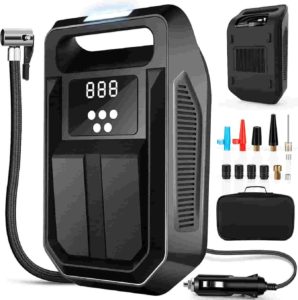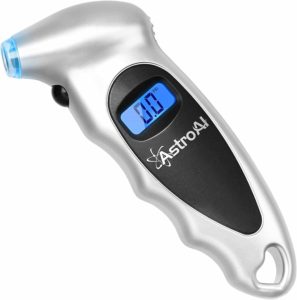Introduction to Nissan Sentra TPMS
Welcome to our comprehensive guide on resetting the tire pressure light in your Nissan Sentra. This guide will take you through the ins and outs of the Sentra’s unique “Easy-Fill Tire Alert” system, which uses both sound and light signals to help you adjust your tire pressures accurately. Whether you’re dealing with a stubborn tire pressure light or just want to understand your car better, we’ve got you covered. Let’s dive in!
How to Reset the Nissan Sentra Tire Pressure Light
The Nissan Sentra does not have a tire pressure reset button. It has an “Easy-Fill Tire Alert” system which provides you with audible and visual signals while adjusting your tire pressures.
Park your Sentra in a safe and level place.
Apply the parking brake and put the SUV in Park.
Put the ignition to the ON position. This means engine off, electricity on.
Check and adjust your tire pressures. As you start adding air, the hazard indicators (front and rear blinkers) will start flashing.
Once the correct amount of air has been reached, the horn of your Sentra will beep once and the hazard indicators will stop flashing. Be exact, fill your front and rear tires to exactly 33 Psi.
Repeat the same steps for every tire. (if the tire is overinflated by more than 4 Psi, the horn will beep and the hazard indicators will flash 3 times, release some air.)
After adjusting the tire pressure, drive the vehicle at speeds above 16 MPH (25 km/h). The low tire pressure warning light does not automatically turn off when the tire pressure is adjusted. Once the Sentra reaches 16 MPH (25 km/h) or more, the light will turn off.
If the low tire pressure warning light flashes for approximately 1 minute and then remains on after you turn the ignition switch to the ON position, the TPMS is not functioning properly. (read more about TPMS malfunction below)
If the light doesn’t go off right away, re-check your tire pressure to make sure they are all at the exact pressure you set them to. If the pressure has decreased, you probably have some sort of leak in that tire.
If your tires are not losing air and the tire light still won’t go out, overfilling your tires by about 10 Psi might wake up your sensors. So, overfill them to about 43 Psi and then drive the Sentra for a few minutes. The tire light should reset. Remember: DO NOT leave the tires at this level, release the extra 10 Psi afterwards.
NOTE: Your TPMS will not reset and turn off the low tire pressure warning light until the tire pressure is set to the recommended pressure and the vehicle is driven at speeds above 16 MPH (25 km/h). If you’ve completed these steps and the tire light STILL won’t go out, There is only one of three things that can be the problem. Either have a faulty tire pressure sensor in one of your wheels OR you have a leak OR your receiver module (control unit) is not communicating with your sensors (this is the least of all likely and is rare).
2023 Nissan Sentra Tire Pressure
TIRE SIZE | FRONT PSI | REAR PSI |
205/60R16 | 33 | 33 |
215/45R18 | 33 | 33 |
215/50R17 | 33 | 33 |
SPARE TIRE | 60 | 60 |
Nissan Sentra Tire Settings
How to Turn Off the Tire Maintenance Light
The tire indicator appears when the Sentra has driven a preset distance to let you know when it’s time for tire rotations.
Apply the parking brake.
Turn the ignition switch to the ON position without starting the engine.
Use the steering wheel switches to select the “Settings” menu on the vehicle information display.
Select “Vehicle Settings“, then “Tire“.
Choose “Tire Maintenance“, then “Reset“.
Press the OK button on your steering wheel.
How to Change Tire Pressure Units
Press the [OK] button on the steering wheel to enter the main menu.
Use the [up] or [down] arrow buttons to select “Settings“.
Press the [OK] button to enter the settings menu.
In the settings menu, select “Tire Pressures“.
Press the [OK] button to enter the tire pressures menu.
In the tire pressures menu, select “Pressure Unit“.
Press the [OK] button to enter the pressure unit menu.
In the pressure unit menu, you can select between “psi“, “kPa“, and “bar“. Use the [up] or [down] arrow buttons to select the desired unit.
Press the [OK] button to confirm your selection.
How Does the Nissan Sentra TPMS Work?
The Direct tire pressure monitoring system (TPMS) in the Nissan Sentra operates through a series of steps involving various components. Here’s a detailed explanation:
Tire Pressure Sensors: Each tire (including the spare in some models) is equipped with a TPMS sensor. These sensors are battery-powered devices that measure the air pressure inside the tire. They are located on the inner part of the rim, attached to the valve stem.
Data Collection: The sensors continuously monitor the air pressure in each tire. When the vehicle is in motion, the sensors are activated and begin transmitting data.
Data Transmission: The sensors send this data wirelessly in the form of radio frequency signals. These signals are transmitted to a central receiver, often referred to as the TPMS control module or the Electronic Control Unit (ECU).
Electronic Control Unit (ECU): The ECU is the system’s central processing unit. It receives the signals from each sensor, interprets the data, and determines if the tire pressure is within the acceptable range set by the manufacturer.
Dashboard Indicator: If the ECU determines that the pressure in one or more tires is too low (typically 25% below Nissan’s recommended level), it triggers a warning light on the vehicle’s dashboard. This is a yellow exclamation mark inside a tire symbol. The specific tire with low pressure will also be shown on the display.
Maintenance and Battery Life: The sensors’ batteries typically last between 5-10 years. When a sensor’s battery dies, the entire sensor needs to be replaced. The TPMS warning light will also light up if there is a malfunction in the system itself, such as a dead battery in one of the sensors. (read more about this below)
Resetting the System: After the tire pressure issue has been addressed, the TPMS needs to be reset.
Safety and Efficiency: The TPMS is a crucial safety feature. Proper tire pressure is important for vehicle handling, tire lifespan, fuel efficiency, and overall safety. By providing real-time pressure information, the TPMS helps drivers maintain their tires in the optimal condition.
Remember, the TPMS is not a substitute for regular tire maintenance. We recommend still using a manual tire pressure gauge to check your pressures.
What is the TPMS Malfunction Indicator
As we just mentioned, the Nissan Sentra has a malfunction indicator to alert you when something is wrong with the system itself. The indicator uses the same yellow exclamation point as the low tire pressure light. The difference is that, if there is a problem with the system, the light will flash for about 1 minute before staying on. This flashing or blinking will happen every time you start your Sentra until the issue is resolved. When your tire light is flashing your Sentra will not be able to give you accurate pressure readings. Basically, a blinking tire pressure light means there is a malfunction within the TPMS itself, rather than an air pressure issue. This is usually due to a faulty pressure sensor in one of your tires (a dead battery) or driving with the spare tire. (if the spare doesn’t have a sensor in it) To figure out which sensor is malfunctioning or faulty, use a TPMS diagnostic tool and scan each sensor for diagnostic information or bring your car to a professional.
Why is the TPMS Malfunctioning?
Using wheels or tires not from Nissan or replacing wheels or tires without sensors.
Electronics that use similar radio frequencies can interfere with the TPMS. This can come from many things like radios, walkie talkies, or store security systems you drive by.
If your Sentra has really dark window tints, it can also interfere with the radio signals going between the TPMS sensors and the receiver.
Driving with your spare tire.
If there is substantial amounts of snow or ice accumulation on or surrounding the tire valves.
If the tire pressure is extremely high.
Driving at extremely high speeds for an extended period of time.
If new tire pressure sensors are installed without registering the new sensor identification codes with the Sentra’s receiver module/ECU. (You need a TPMS diagnostic tool to do this)
What Causes the Tire Pressure Light to Turn On?
Weather Changes: A drop in ambient temperature can cause tire pressure to decrease, triggering the warning light. This is very common in fall and winter seasons.
Tire puncture or leak: An object with a sharp edge or roadway debris such as a nail or screw could pierce a tire, leading to a loss of air that will subsequently trigger the warning light.
Faulty tire pressure sensor: Damaged or malfunctioning sensors may provide inaccurate readings, resulting in a false alert. The only way to determine which sensor is faulty is to scan each sensor with a TPMS diagnostic tool.
Valve stem issues: A faulty or leaking valve stem can result in a slow loss of pressure, ultimately causing the tire pressure light to illuminate. There are available kits designed to replace the rubber gasket that usually goes bad.
Tire damage: Impact from potholes or hitting a curb can cause structural damage like tire bubbles, leading to pressure loss.
Sensor battery life: TPMS sensors are battery-powered, and over time, batteries die. (they usually last anywhere from 5-10 years) This will cause the tire pressure light to turn on. Again, you must use a diagnostic tool to determine which sensor is dead or dying.
Recent tire rotation or replacement: If you have recently rotated or replaced your tires, the TPMS may need recalibration to avoid false alerts. Sometimes the vehicle’s computer may think the front tires are in the rear and rear in the front after a rotation.
Wheel issues: Cracked, corroded or damaged wheels can lead to air leaks and pressure loss. This is very common with low profile tires.
Altitude changes: Climbing or descending in elevation can affect tire pressure and trigger the TPMS warning. An additional 1.5 Psi per Kilometer above sea level is recommended.
Natural pressure loss: Over time, tires experience a decrease in air pressure due to fluctuations in temperature and permeation. Tires that sit for extended periods will develop dry rot, eventually leading to pressure loss.
Software Updates: Occasionally Nissan may put out a software update for the Sentra’s TPMS.
Snow Tires: If you have a separate pair of wheels for your snow tires, you can either transfer the sensors from your summer wheels or acquire an additional set of 4 sensors for the second pair of wheels. However, if you are using the same wheels for both sets of tires, don’t worry about this.
What are the Effects of Underinflated or Overinflated Tires?
Effects of Underinflated Tires:
Poor Fuel Efficiency: Underinflated tires make your Sentras’ engine work harder, using more gas.
Bad Handling: Your Sentra might not respond well when you steer.
Tire Damage: Tires can wear out faster along the edges creating uneven tread.
Overheating: Tires can get too hot, which could lead to a blowout.
Effects of Overinflated Tires:
Rough Ride: Overinflated tires can make the ride feel bumpy.
Less Traction: Your tires might not grip the road as well.
Wear in the Middle: The middle of the tire will wear out faster.
Damage Risk: Overinflated tires are more likely to get damaged by potholes or debris.
Does the Weather Affect Tire Pressure?
Weather plays a big role in your Sentra’s tire pressure. When it’s cold, air contracts and your tire pressure will drop. But when it’s hot, air expands and your tire pressure will go up. So, always check your tires when the weather changes! Keep in mind that for every 10-degree Fahrenheit drop in temperature your tire pressure decreases by about 1 PSI.
How to Adjust Tire Pressure
Make sure the tires are cold.
Remove the valve cap from the tire.
Press the tip of the tire pressure gauge onto the valve and read the pressure.
If the tire pressure is below the recommended level (33 Psi), fill the tire with air until 33 Psi is reached. If the tire pressure is above 33 Psi, release air until it’s at exactly 33 Psi. (Press the metal stem in the center of the tire valve. You can use any object like a screwdriver to do this. Be gentle.)
After adjusting the tire pressure, don’t forget to put the valve caps back on to prevent leaks and keep dirt and moisture out.
Repeat this process for each tire, including the spare if applicable.
What is "cold Pressure"?
To get a correct and accurate tire pressure reading on your Nissan Sentra, check the air pressure when the car has been sitting for a while. This is known as checking the “cold pressure” after the car hasn’t moved for about three hours or more. Driving heats up your tires, causing the air inside to expand and show a falsely high pressure reading. So, don’t adjust your tire pressure right after driving or your tires will end up overinflated!
Conclusion
And there you have it – a complete guide to understanding and resetting the tire pressure light in your Nissan Sentra. We’ve covered everything from the basics of the “Easy-Fill Tire Alert” system to the effects of tire pressure on your vehicle’s performance. Remember, maintaining the right tire pressure is crucial for your safety and your car’s efficiency. So, keep this guide handy and ensure your Sentra is always in top shape. Safe driving! Everything in this article is applicable to all Nissan Sentra models and trims. This includes the Sentra S, Sentra SV, Sentra SR.
FAQ
Q: Why is my tire pressure light on when my tires are fine on my Nissan Sentra?
A: Your Nissan Sentra’s tire pressure light might be on even if your tires appear fine due to a variety of reasons. One common cause is a change in temperature, which will affect your tire pressure. Also, the tire pressure monitoring system (TPMS) could be malfunctioning or the sensor battery could be low. It’s always best to manually check your tire pressure to ensure it’s within the recommended range. If the light persists, consider having your vehicle inspected by a professional.
Q: Why is my tire pressure light on with full tires?
A: If your tire pressure light is on even though your tires are fully inflated, it could be due to an issue with the tire pressure monitoring system (TPMS). The TPMS sensors can sometimes give false readings due to a malfunction or a low battery. It’s also possible that one of your tires is overinflated, which can also trigger the light. Always double-check the pressure with a manual gauge and consult with a professional if the light stays on.
Q: Is it bad to drive with the tire pressure light on?
A: Driving with your tire pressure light on isn’t recommended. The light is a warning that one or more of your tires may not be properly inflated. Improper tire pressure can lead to decreased fuel efficiency, poor handling, increased tire wear, and even a blowout. If your tire pressure light comes on, it’s best to pull over when it’s safe and check your tire pressure.
Q: Can I ignore the tire pressure light?
A: Ignoring the tire pressure light isn’t advisable. The light is a safety feature designed to alert you to potential issues with your tire pressure. Ignoring it could lead to serious problems, including decreased vehicle performance and safety. If your tire pressure light comes on, you should check your tire pressure as soon as possible and inflate or deflate your tires as needed. If the light remains on after adjusting the tire pressure, it’s recommended to have your vehicle inspected by a professional.
Q: Where is the TPMS reset button on a Nissan Sentra?
A: There isn’t one.
Please note that this blog post contains Amazon affiliate links. This means that if you make a purchase through one of these links, we at TPMSRESET.com may earn a small commission at no extra cost to you. We only recommend products that we personally use and believe in. Thank you for supporting us.





